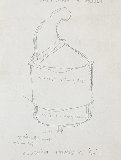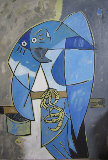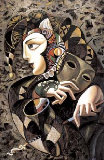-

-
Albert Gleizes
FranceArt Brokerage: Albert Gleizes French Artist: b. 1881-1953. Born Albert Léon Gleizes and raised in Paris, he was the son of a fabric designer who ran a large industrial design workshop. He was also the nephew of Léon Comerre, a successful portrait painter who won the 1875 Prix de Rome. Gleizes began to paint self-taught around 1901 in the Impressionist tradition. His first landscapes from around Courbevoie appear particularly inspired by Sisley or Pissarro. Although clearly related to Pissarro in technique, Gleizes' particular view-points as well as the composition and conception of early works represent a clear departure from the style of late Impressionism. The density with which these works are painted and their solid framework suggest affinities with Divisionism which were often noted by early critics. Gleizes was only twenty-one years of age when his work titled La Seine à Asnières was exhibited at the Société Nationale des Beaux-Arts in 1902. The following year Gleizes exhibited two paintings at the Salon d'Automne. In 1905 Gleizes was among the founders of l'Association Ernest-Renan, a union of students opposed to military propaganda. Gleizes was in charge of the Section littéraire et artistique, organizing theater productions and poetry readings. Tending towards 1907 his work evolved into a Post-Impressionist style with strong Naturalist and Symbolist components. Gleizes and others decide to create an association fraternelle d'artistes and rent a large house in Créteil. The Abbaye de Créteil was a self-supporting community of artists that aimed to develop their art free of any commercial concerns. For nearly a year, Gleizes along with other painters, poets, musicians and writers, gathered to create. A lack of income forced them to give up their cherished Abbaye de Créteil in early 1908 and Gleizes moved to rue du Delta near Montmartre, Pari. The same year, showing a great interest in color and reflecting the transient influence of Fauvism, the work of Gleizes became more synthetic with a proto-Cubist component.nn nnn Albert Gleizes, 1911, Portrait de Jacques Nayral, oil on canvas, 161.9 x 114 cm, Tate Modern, London. This painting was reproduced in Fantasio: published 15 October 1911, for the occasion of the Salon d'Automne where it was exhibited the same year.nGleizes' Fauve-like period was very brief, lasting several months, and even when his paint was thickest and color brightest, his concern for structural rhythms and simplification was dominant. His geometric simplifications at this time were more akin to Pont-Aven School and Les Nabis principles than to Paul Cézanne. His landscapes of 1909 are characterized by the reducing of forms of nature to primary shapes. During the summer of the same year his style became linear and stripped, broken down into multiple forms and facets with attenuated colors, close to that of the painter Henri Le Fauconnier. In 1910 a group began to form which included Gleizes, Metzinger, Fernand Léger and Robert Delaunay. They met regularly at Henri le Fauconnier's studio on rue Notre-Dame-des-Champs, near the Boulevard de Montparnasse. These soirées would often included writers such as Guillaume Apollinaire, Roger Allard, René Arcos, Paul Fort, Pierre-Jean Jouve, Alexandre Mercereau, Jules Romains and André Salmon. Together with other young painters, the group wanted to emphasise a research into form, in opposition to the Neo-Impressionist emphasis on color. From 1910 onwards, Albert Gleizes was directly involved with Cubism, both as an artist and principle theorist of the movement. Listings wanted.
Read More + - Create Listing 0 Artworks for sale 2 Followers
-
We are actively seeking listings for Albert Gleizes.
Create a free listing or free wanted ad.




































